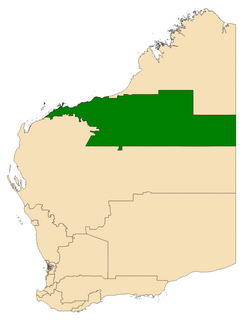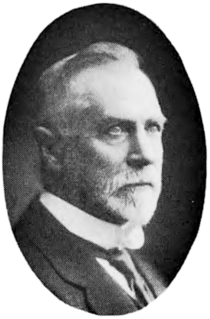Related Research Articles
The National Labor Party was formed by Australian Prime Minister Billy Hughes in 1916, following the 1916 Labor split on the issue of World War I conscription in Australia. Hughes had taken over as leader of the Australian Labor Party and Prime Minister of Australia when anti-conscriptionist Andrew Fisher resigned in 1915. He formed the new party for himself and his followers after he was expelled from the ALP a month after the 1916 plebiscite on conscription in Australia. Hughes held a pro-conscription stance in relation to World War I.

The Electoral district of Pilbara is a Legislative Assembly electorate in the state of Western Australia. Pilbara is named for the region of Western Australia in which it is located. It is one of the oldest electorates in Western Australia, with its first member having been elected to the Second Parliament of the Legislative Assembly at the 1894 elections.
This is a list of members of the Western Australian Legislative Council from 22 May 1922 to 21 May 1924. The chamber had 30 seats made up of ten provinces each electing three members, on a system of rotation whereby one-third of the members would retire at each biennial election. During the term, the Country Party split into rival Ministerial (MCP) and Executive (ECP) factions–although in the Council, this was diluted somewhat by the refusal of some long-standing Country members to become involved in the dispute. The Executive faction, loyal to the Primary Producers' Association, prevailed and by 1925 the Ministerial faction had merged with the Nationalist Party.
This is a list of members of the Western Australian Legislative Council from 22 May 1924 to 21 May 1926. The chamber had 30 seats made up of ten provinces each electing three members, on a system of rotation whereby one-third of the members would retire at each biennial election. In the previous term, the Country Party split into rival Ministerial (MCP) and Executive (ECP) factions. The Executive faction, loyal to the Primary Producers' Association, prevailed and by 1925 the Ministerial faction had merged with the remnants of the National Labor Party into the Nationalist Party.
This is a list of members of the Western Australian Legislative Assembly between the 1921 election and the 1924 election, together known as the 11th Parliament. During the term, the Country Party split into rival factions, the Ministerial Country Party (MCP) which comprised the bulk of the parliamentary party—many of whom had switched allegiance from other parties since 1919—and the Executive Country Party (ECP), which was loyal to the Primary Producers' Association, which the Country Party was intended to represent in Parliament. After the 1924 election, which significantly strengthened the latter at the expense of the former, the Ministerial arm merged with the Nationalist Party.
This is a list of members of the Western Australian Legislative Assembly between the 1924 election and the 1927 election, together known as the 12th Parliament. During the previous term, the Country Party had split into rival factions, the Ministerial Country Party (MCP) which comprised the bulk of the parliamentary party—many of whom had switched allegiance from other parties since 1919—and the Executive Country Party (ECP), which was loyal to the Primary Producers' Association, which the Country Party was intended to represent in Parliament. After the 1924 election, which significantly strengthened the latter at the expense of the former, the Ministerial arm merged with the Nationalist Party, as did the National Labor Party, which lost most of its representation in the election.
This is a list of members of the Tasmanian House of Assembly between the 10 June 1922 election and the 3 June 1925 election. The fledgling Country Party got five members elected, including two former Nationalists, but by the end of the term the party had all but merged into the Nationalist Party. A new Liberal Party emerged before the 1925 election, counting the support of three MHAs.
The First Mitchell Ministry was the 15th Ministry of the Government of Western Australia and was led by Nationalist Premier James Mitchell. It succeeded the Colebatch Ministry on 17 May 1919 after the collapse of Hal Colebatch's brief service as Premier. It assumed a stability which had been absent from Western Australian politics since the 1914 election. The ministry was followed by the Collier Ministry on 15 April 1924 after the Nationalist coalition lost government at the state election held on 22 March.

Charles Frederic John North was an Australian lawyer and politician who was a member of the Legislative Assembly of Western Australia from 1924 to 1956, initially representing the Nationalist Party and later the Liberal Party. He was Speaker of the Legislative Assembly from 1947 to 1953.
The 1927 Victorian state election was held in the Australian state of Victoria on Saturday, 9 April 1927, to elect the 65 members of the state's Legislative Assembly.

The 1924 Victorian state election was held in the Australian state of Victoria on Thursday 26 June 1924 to elect the 65 members of the state's Legislative Assembly.

Elections were held in the state of Western Australia on 26 March 1927 to elect all 50 members to the Legislative Assembly. The incumbent Labor Party government, led by Premier Philip Collier, won a second term in government against the United-Country opposition, led by Opposition Leader James Mitchell.

Elections were held in the state of Western Australia on 22 March 1924 to elect all 50 members to the Legislative Assembly. The incumbent Nationalist-Majority Country government, led by Premier James Mitchell, was defeated by the Labor Party opposition, led by Opposition Leader Philip Collier.
The Executive Country Party was a splinter group from the Western Australian branch of the Country Party of Australia that was active in the mid-1920s. It was led by the state deputy leader of the Country Party, Alec Thomson. The members of the Executive faction wanted better representation of the Primary Producers' Association by the party, while the remainder chose to primarily support the Nationalist coalition led by then Premier James Mitchell. In 1923, 3 members of the 16-member Country Party split to form the ECP.
Elections were held in the state of Western Australia on 12 March 1921 to elect all 50 members to the Legislative Assembly. The incumbent government, led by Premier James Mitchell of the Nationalist Party and supported by the Country Party and National Labor Party, won a second term in government against the Labor Party opposition, led by Opposition Leader Philip Collier.
Frederick James Withers was an Australian politician who was a Labor Party member of the Legislative Assembly of Western Australia from 1924 to 1947, representing the seat of Bunbury. He was later mayor of the City of Bunbury from 1951 to 1955.

Thomas Hamlet "Tom" Harrison was an Australian politician who was a Country Party member of the Legislative Assembly of Western Australia from 1914 to 1924. He was the leader of the Country Party from 1919 to 1922.
James Cornell was an Australian politician who served as a member of the Legislative Council of Western Australia from 1912 until his death. He was elected President of the Legislative Council in July 1946, but served just four months before dying in office.
George William Barnard was an Australian politician who was a Nationalist Party member of the Legislative Assembly of Western Australia from 1924 to 1933, representing the seat of Sussex.
References
- ↑ "Former Members". Parliament of Western Australia. 2011. Archived from the original on 27 September 2011. Retrieved 6 October 2011.
| This article about a Nationalist Party of Australia politician is a stub. You can help Wikipedia by expanding it. |
| This article about an Australian Independent politician is a stub. You can help Wikipedia by expanding it. |